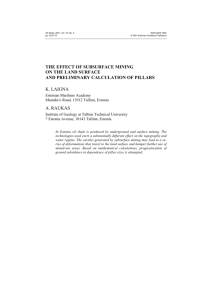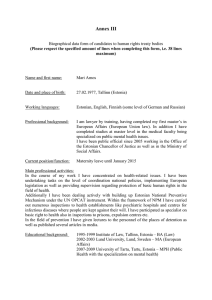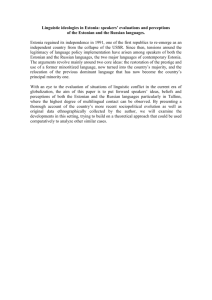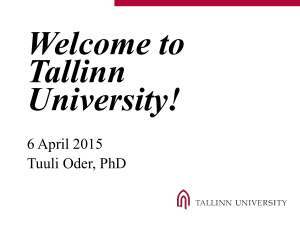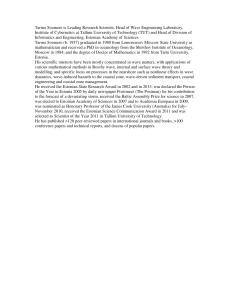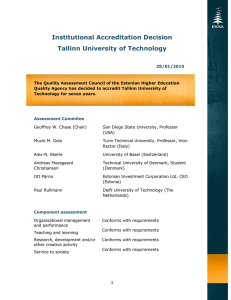the internationalization of Estonian Higher Education: How the
advertisement
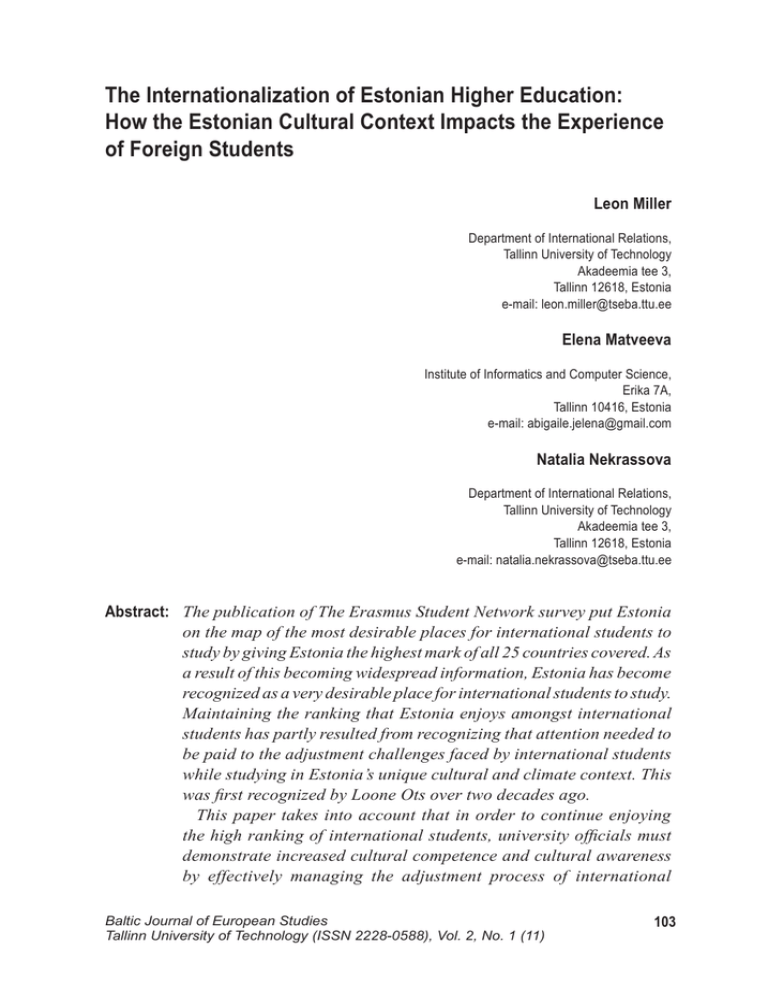
The Internationalization of Estonian Higher Education: How the Estonian Cultural Context Impacts the Experience of Foreign Students The Internationalization of Estonian Higher Education: How the Estonian Cultural Context Impacts the Experience of Foreign Students Leon Miller Department of International Relations, Tallinn University of Technology Akadeemia tee 3, Tallinn 12618, Estonia e-mail: leon.miller@tseba.ttu.ee Elena Matveeva Institute of Informatics and Computer Science, Erika 7A, Tallinn 10416, Estonia e-mail: abigaile.jelena@gmail.com Natalia Nekrassova Department of International Relations, Tallinn University of Technology Akadeemia tee 3, Tallinn 12618, Estonia e-mail: natalia.nekrassova@tseba.ttu.ee Abstract: The publication of The Erasmus Student Network survey put Estonia on the map of the most desirable places for international students to study by giving Estonia the highest mark of all 25 countries covered. As a result of this becoming widespread information, Estonia has become recognized as a very desirable place for international students to study. Maintaining the ranking that Estonia enjoys amongst international students has partly resulted from recognizing that attention needed to be paid to the adjustment challenges faced by international students while studying in Estonia’s unique cultural and climate context. This was first recognized by Loone Ots over two decades ago. This paper takes into account that in order to continue enjoying the high ranking of international students, university officials must demonstrate increased cultural competence and cultural awareness by effectively managing the adjustment process of international Baltic Journal of European Studies Tallinn University of Technology (ISSN 2228-0588), Vol. 2, No. 1 (11) 103 Leon Miller, Elena Matveeva, Natalia Nekrassova students. This premise is consistent with the data collected by the research team at the Department of Economics of the Tallinn University of Technology. The results of the research have strengthened the research team’s conviction that Estonian educational authorities best fulfill the proposed internationalization plan for 2006–2015 by both managing the challenges of the internationalization of university level education in Estonia as well as researching the particular problems international students have in adjusting to higher education in the Estonian cultural context. Keywords:cultural adjustment, cultural fatigability, cultural shock (CSH), selfidentification 1. Introduction: the internationalization of higher education The concept ‘university’ implies that the scope of the university community is itself international. This is based on the premise that reliable knowledge cannot be produced in local isolation but can only be obtained by an open and honest inquiry that is international in its scope. That is, the nature of today’s global reality necessitates structuring the higher learning experience so that it prepares the student to deal with the globalized world and with global interdependence. The main aspect of these modern developments, as far as domestic centers of higher education are concerned, is the internationalization of educational services and educational institutions. Internationalization is driven by national, regional and global forces pressuring universities to engage and attract international scholars, plus engage and attract international students as the means of raising their reputation to international standards by engaging in reliable knowledge exchange with international partners. Famed consultant on organizational behavior Peter F. Drucker (1999, p. 61) points out that the internationalization of organizations (due to the impact of globalization) accentuates the necessity of making global competitiveness a strategic goal for all institutions. He stresses that universities, as well as all other current organizations, cannot compete/survive unless they measure up to international standards set by the leading universities (anywhere in the world). The Erasmus Student Network recently published a new survey for 2010. This new survey reveals that, when asked to rate the overall level of satisfaction with their experience as an international student studying abroad, visiting international 104 Baltic Journal of European Studies Tallinn University of Technology (ISSN 2228-0588), Vol. 2, No. 1 (11) The Internationalization of Estonian Higher Education: How the Estonian Cultural Context Impacts the Experience of Foreign Students students gave Estonia the highest marks of all 25 countries covered (Study in Estonia, 2010). Estonia’s reputation as a study center has been influenced by this becoming widespread information resulting in increasing numbers of international students deciding to study in Estonia. Consequently, Estonia is witnessing an increase in students coming from such exotic and sunny places such as the Caribbean, the Mediterranean, and South East Asia. Although this poses an opportunity for Estonia, it also poses a tremendous challenge. The challenge lies in keeping in mind that the high ranking Estonia enjoys cannot be maintained without considering the adjustment challenges that students face when studying in the Estonian cultural and geographical climate. There are a growing number of research articles pointing out the challenges university systems face connected with the increasing internationalization of education. According to the Estonian Higher Education Strategy 2006–2015, the Estonian Ministry of Education, for example, acknowledges that for several reasons (including its demographics) it is necessary to plan an effective response to the demand for the internationalization of its university programs (Estonian Higher Education…, 2006). In relation to the Eurostudent report, the most prominent mobility of the students can steadily increase because in the European Higher Education Area students have had a study or training period abroad (Orr, Gwosć & Netz, 2011). However, the European Commission has stressed in its 2011 Communication to the European Parliament and other institutions that the fact of Estonia enjoying an increase in the influx of international students within itself is not enough. In other words the increased number of international students attracted to studying in a particular locale must be matched by the center’s effort to improve the outcomes and overall conditions of the international student (EC, 2011). In other words, according to Drucker (1999, pp. 58–60, 80–81), staying ahead of the rapidly changing conditions of today’s globally networked information economy demands continuous performance improvement in ways that will result in the continuous satisfaction of clients and stakeholders. Accompanying the need for research on managing the challenges of the internationalization of university-level education in Estonia is also the need for research on the particular problems students have in adjusting to the internationalization of higher education in the Estonian cultural context. This corresponds with the admonition of Loone Ots based on earlier research on the experience of international students studying in Estonia (Ots, 1998, p. 376). Loone Ots began to observe over two decades ago that there was already a growing interest amongst foreign students for studying in Estonia. Ots thought Baltic Journal of European Studies Tallinn University of Technology (ISSN 2228-0588), Vol. 2, No. 1 (11) 105 Leon Miller, Elena Matveeva, Natalia Nekrassova the increase could be due to “[a]n attraction to what appears to be an exotic place, a general desire to become acquainted with former socialist countries and an interest in visiting as many other different universities/countries as possible.” However her article also highlighted the fact that almost all foreign students were reporting having cultural shock as a part of the adjustment to studying in Estonia (Ots, 1998, p. 376). This article explores the challenges connected with the internationalization of higher education in Estonia; however, the primary concern is on facilitating internationalization in a way that enhances the learning experience for students in international programs. This article is based on a quantitative measurement of the need to address the adjustment challenges students face when studying at the Tallinn University of Technology. In this respect the article examines the adjustments necessary because of the culture shock that students experience in an unfamiliar cultural environment. The first segment of the article reviews the research done on the adjustment challenges international students face when studying in a new cultural environment. Much of the research describes this adjustment process as cultural shock. Thus, the article introduces and describes the role of culture shock in the adjustment efforts of international students and introduces why it is a factor in the adjustment process of foreign students. The second segment of the article describes current research done on the adjustment of international students. The emphasis here is on the type of things a university must keep in mind to better facilitate the transition of its international students. The third segment of the article quantitatively measures the features of culture shock on the experience of foreign students participating in the English-speaking International Program at the Tallinn University of Technology. The final section of the article summarizes the significance of facilitating the adjustment process of international students as part of the internationalization planning of institutions of higher learning. 2.Literature review Multiculturalism, increased diversity, immigration and student mobility are some of the factors that challenge programs of higher learning to facilitate a greater number of international students. Estonia, for example, is enjoying the reputation of being an attractive place for international students to study. Thus, as a result of Estonia attracting larger numbers of international students 106 Baltic Journal of European Studies Tallinn University of Technology (ISSN 2228-0588), Vol. 2, No. 1 (11) The Internationalization of Estonian Higher Education: How the Estonian Cultural Context Impacts the Experience of Foreign Students it is also a good place for doing research on the experience of international students studying in the unique Estonian cultural context. In accordance with this Estonian higher educational authorities are increasingly recognizing the value of research on the unique experience of international university students who study in the Estonian cultural context. The internationalization of higher education has increased the challenge that students face in adjusting to unknown cultures. These challenges have been studied by specialists analyzing different aspects of the educational process and the impact that internationalization has on the educational process. Their careful analysis reveals that one of the difficulties that students face in adjusting to studying abroad is culture shock (occurs when an unfamiliar culture has a stressful influence on a person, sometimes described as cultural fatigability or just stress). The term ‘culture shock’ was introduced by Kalervo Oberg in 1960 (Oberg, 1960) when he noticed that entering a new culture can be accompanied by a number of unpleasant feelings. Nowadays it is considered that the experience of culture shock is stressful because it is unexpected, on the one hand, and can lead to a negative evaluation of the new culture, on the other. The stressful impact of a new culture on a person is called culture shock, or stress, or marginal stress, or cultural stress fatigue by contemporary scholars. Most people who have changed their place of residence to a new culture suffer from some degree of culture shock. Culture shock has psychological and physical consequences that play a role in the adjustment to new situations. Today, local centers of higher education enjoy a vast increase in the number of foreign students but if institutions of higher learning fail to take cultural competence into consideration, students can be left with various unpleasant emotions connected with adjusting to an unfamiliar culture (Nekrassova & Matveeva, 2010, pp. 4–12). Students can face adjustment difficulty that is felt as culture shock and such unexpected experiences may lead to a negative appraisal of the culture and the educational experience. Culture shock can be defined as an unpleasant and extreme reaction during the common process of adaptation to new conditions. But in spite of the stress, the person adjusting to new cultures is becoming enriched and more developed due to enhanced cultural knowledge and competence. Since the 1990s this common experience is typical to people and is often identified as ‘acculturative stress’ rather than culture shock (Berry, 2006, pp. 43–57). Helen Spencer-Oatey and Peter Franklin (2009) explained that culture shock can occur in one or all of the following ways: pressure because of the efforts applied to an attempt at psychological adaptation; a sense of loss in relation to friends, status, profession Baltic Journal of European Studies Tallinn University of Technology (ISSN 2228-0588), Vol. 2, No. 1 (11) 107 Leon Miller, Elena Matveeva, Natalia Nekrassova and possessions; a feeling of isolation in a new culture which can turn to an unpleasant experience in the unknown culture; confusion of role expectations and the feeling of self-identification; anxiety passing into indignation after the comprehension of cultural differences; a feeling of inadequacy because of the inability to cope with the situation. The main reason for culture shock is that experiences and interactions in the new cultural setting do not conform to an individual’s psychological expectations. Every culture has its own unique set of symbols and images, expected patterns of behavior and interactions that are common to various situations within the culture. The environment of a new culture makes the individual’s habitual system of orientation inadequate because it is based on a different representation of the world, different norms and values, plus different perceptions of behavior, and different behavioral expectations. Interacting in a culture that one is habituated in means that the person can behave without thinking about the existence of a majority of factors that lie beneath appearances (see the ‘cultural iceberg theory’ in Trompenaars, 1998). In other words, as Trompenaars points out, there is a whole realm of significant information about a culture that is not apparent, resulting in a hidden system controlling behavioral norms and values. Thus, when a person has contact with an unknown culture he or she can feel psychologically and sometimes physically uncomfortable. This feeling of discomfort is the result of culture shock. The level of intensity, duration, and need for adaptation due to cultural shock depends on many factors. One of the most important factors is the previous experience of living in an unknown cultural environment. The more exposure a person has had to diversity the more the person is prepared for a better adjustment. However all of the factors can be divided into two categories: internal (personal) and external (group). In the first category of ones the most important factors that need to be taken into consideration are the individual characteristics of a person—such as gender, age and personal traits. Gender influences the process of adaptation and duration of culture shock (hereafter CSH). Research on what is involved in adapting to new cultural settings states that the process of adjustment to a new environment is more complicated for women than it is for men. However this is most common when women come from traditional cultures where their life is limited to activity around the home. As for women from developed countries these differences are blurred and research indicates that women can be as successful as men in adapting to new cultural settings. 108 Baltic Journal of European Studies Tallinn University of Technology (ISSN 2228-0588), Vol. 2, No. 1 (11) The Internationalization of Estonian Higher Education: How the Estonian Cultural Context Impacts the Experience of Foreign Students The age of a person is considered to be a significant adjustment factor in the process of adapting to an unknown community. The older the person is, the more difficult the adjustment to a new cultural system, it is harder and takes longer to overcome CSH, and older people more slowly overcome the difficult challenges that patterns of an unknown culture pose for them. Educational factors are more and more becoming a considerable adjustment factor, the more educated the person, the more successful his or her adaptation. Education, even without taking into account its cultural content, expands the internal resilience potential of a person. The more complex the inner world of a person, the faster and easier the time needed for creative innovation. Among the external factors influencing adjustment and CSH, cultural distance can be designated as a main one. The person’s perception of cultural distance depends on many factors: economic factors, emotional factors and the person’s language skills. If the values of one’s culture differ from those of another culture and cultural difference is huge, adjustment can be long and painful. The circumstances of one’s life experience (related to the internal factors of adjustment and the motivation to adjustment) are the most influential factors. This aspect of motivation is very high among students who are studying abroad. In order to reach their goals they try to adjust as quickly as possible. The peculiarities of one’s culture can be crucial to adjustment. For representatives of nationalities who are afraid to “lose face” or for those of the more powerful nations (G8 countries) the adjustment is mostly stressful. The social and cultural conditions of the visiting country, such as the friendliness of locals to foreign students, their willingness to help foreign visitors and socialize with them, are very essential for aiding a healthy adjustment. CSH is a complex process for students but the results which can be reached (such as new perceptions of the world based on understanding and accepting cultural diversity) are worth the effort it takes to overcome it. The key advantage of effectively managing CSH is the priceless experience and acquired skills students can draw from while living and working in our rapidly changing world with reduced borders where competence in intercultural relations is becoming more important. The Bologna Accord, with its intention to attract worldwide academic cooperation, has played a role in the increased migration of students from many parts of Europe, Central Asia, Asia, Southeast Asia and the Far East. The enlargement of the European Union has influenced the ethnic diversity of Baltic Journal of European Studies Tallinn University of Technology (ISSN 2228-0588), Vol. 2, No. 1 (11) 109 Leon Miller, Elena Matveeva, Natalia Nekrassova students at Estonian educational institutions and the educational environment is becoming more and more multicultural (see Fig. 1 below). These changes have a great impact on both the teaching and studying processes. Figure 1. The number of international students studying in Estonia in 2010 Middle East Africa Asia Other Finland China Turkey Russia Other Europe Other EU Baltics Thus, the aims of education have to reflect the current situation in the educational environment. In light of internationalization increasing crosscultural competence has to be an integral part of the university’s plan for effectively managing internationalization. This demands the training of future university specialists in enhancing cross-cultural interactions and the university must consider implementing procedures to manage the consequences of CSH. The combination of didactic and empirical methods of teaching can be very effective if the teachers are familiarized with studies on building cross-cultural competence. According to Ting-Toomey (1999, p. 194) without appropriately facilitating the student’s adjustment process to studying in a foreign cultural context students are more likely to experience a prolonged period of feeling confusion over values, norms, processes as well as over content, identity, relational and procedural issues. On the other hand, as Ting-Toomey points out, careful attention to the adjustment process of students studying in this culture helps them to have not only a better learning experience but helps them to grow (mature) as individuals as a result of an enriching cultural experience. Improving the performance of students attending higher education programs in Estonia demands attending to the factors involved in their adjustment to the Estonian cultural context. Estonian institutions of higher education are increasing the effectiveness of their effort to appeal to international students and 110 Baltic Journal of European Studies Tallinn University of Technology (ISSN 2228-0588), Vol. 2, No. 1 (11) The Internationalization of Estonian Higher Education: How the Estonian Cultural Context Impacts the Experience of Foreign Students their ability to offer an enriching learning experience by carefully planning the internationalization of its programs. This includes taking CSH as an adjustment factor in the learning experience into consideration. 3. Methodology of research Aim of research: to explore and single out the main components of the culture shock among the first-year foreign students studying at the Tallinn University of Technology. Research subject: a group of foreign students, studying in the English-language program at the Tallinn University of Technology. The sample size was 61, between the ages of 18 and 45. Object of research: the peculiarities of CSH in the context of the international program of foreign students of the Tallinn University of Technology. Research hypothesis: It is supposed that while studying in the international program at the Tallinn University of Technology, CSH has specific features that are experienced by students. Research objective: Determine the peculiar features and components of the CSH for students studying in Estonia. Methods of research: The basic method of research for this study is experiment. The basic method used for collecting empirical data is testing. The method used for statistical data handling is quantitative analysis and qualitative analysis is carried out by content analysis. Content analysis is a research technique for objective, systematic, and quantitative description of content. Content analysis is a research tool which is used in cross-cultural researches. Data collection: Culture shock test The culture shock (CSH) methodology was developed by Galina Bardier (2002). Empirical research on culture shock was initially developed by Bardier as a method of qualitative research, where the respondents’ answers were processed with content-analysis techniques. During a pilot study, a method similar to the Who-am-I? test by Manford Kuhn and Thomas McPartland (Kyn & Makpartland, 1984) was experimented with for the purpose of further developing the Whoam-I? test. In the beginning, the given instructions allowed the students to freely express themselves. The respondents were asked to describe situations in which Baltic Journal of European Studies Tallinn University of Technology (ISSN 2228-0588), Vol. 2, No. 1 (11) 111 Leon Miller, Elena Matveeva, Natalia Nekrassova they experienced or faced CSH. Later, however, the instructions become more precise and a definite understanding of CSH was called for. The final version of research methodology was developed on the base of the perception of CSH as a reflection of cultural differences (see Appendix 1). The following criteria are proposed for selecting the categories of content analysis results of the CSH measurements: 1. Components of the settings and the most common ethnic traits dominant in a particular situation: • ‘Cognitive’—connected mostly with presentation, beliefs and understanding; • ‘Affective’—connected mostly with feelings, emotions and understanding; • ‘Connotative’—connected mostly with behavioral activity. 2. The intensity of personal involvement in a situation: • Consciousness of personal involvement in the situation; • Unconsciousness of a situation—previous personal experience is used as a reference; • Unconsciousness of a situation on the basis of national traditions and collective experience. 3. Sources for the appearance of intolerance in a situation: • Active intolerance—a subject of communication himself is the source of intolerance; • Reactive intolerance—the object is another person, a communication partner; • Situational intolerance—sources which are occasional circumstances which spontaneously and vividly reveal cross-cultural differences. 4. Further development of the situational criteria: • ‘Obstacle’—fixation of contradictions in cross-cultural communication and a number of negative ethnic stereotypes, which decelerate the further development of the interactions; • ‘Vector’—the changing of the content results in the changing of situation as a whole, the contradictions can either be resolved or, on the contrary, exaggerated; • ‘Fan’—the appearance of multi-dimensional situations which include both ethnic stereotypes, the circumstances of their appearance and the personal traits of interacting partners. 5. Positional symmetry/asymmetry of the installation of an object: 112 Baltic Journal of European Studies Tallinn University of Technology (ISSN 2228-0588), Vol. 2, No. 1 (11) The Internationalization of Estonian Higher Education: How the Estonian Cultural Context Impacts the Experience of Foreign Students • Open intolerance—pressure, aggression, hostility; • Hidden intolerance—adjustment, forced submission, abandonment of personal/national identity; • Tolerance—acceptance of the other’s identity without damaging one’s own personal identity. 6. Interaction history of the cultures: • Assimilation experience—affiliation resulting from one culture’s assimilation to another; • Exposure experience—discrimination, colonization; • Integration experience—overcoming segregation and confrontation. 7. Situation related to a specific field of cultural expression: • Intolerance in the sphere of worldview—values, world outlook, ethics, aesthetics; • Conventional intolerance—personal space, interpersonal distancing, the ways emotions are expressed, common patterns of building relationships, ways of thinking, problem solving, public behavior; • “Everyday” intolerance—food, clothes, manners, basic necessities of life. Data analysis: Culture shock test For the study of CSH 61 students were questioned and questionnaires from 26 respondents were returned (Table 1). The students were asked to describe situations when they felt culture shock when meeting an unknown culture. 34 10 20 11 13 42 9 65 32 31 7 5 15 61 9 17 10 Everyday life spheres Conventional Integration Assimilation Tolerance Hidden Open Fan Vector Obstacle Case Object Traditions Unconscious Conscious Connotative Cognitive Affective Table 1. Peculiarities of CSH manifestation and criteria of CSH manifestation (n=26), % 20 The largest number of responses was determined by the Attitude Criterion on the affective component of Attitude Criteria—34 per cent of all responses. According to the Level of Personal Involvement Criterion of CSH, 42 per cent of the respondents interpret the situations in which they feel discomfort as a manifestation of traditionalism—as manifestation of traditions operating at an unconscious level. Baltic Journal of European Studies Tallinn University of Technology (ISSN 2228-0588), Vol. 2, No. 1 (11) 113 Leon Miller, Elena Matveeva, Natalia Nekrassova In terms of Source Criterion the majority of respondents (65% of responses) indicated casual manifestations: for example, natural circumstances and differences in the understanding of a situation were connected with how they experienced the situation. The situation is fixed as an obstacle by the Forecast of the Shock Development Criterion—35 per cent of responses—but there is a trend that in other circumstances the anxiety-producing situations cannot happen (Vector Component); in the case of changing the context of a situation there is no feeling that this situation can happen again—31 per cent of responses. Under the Disposition Criterion the personal disposition was revealed, yielding 60 per cent of tolerance reactions. As for intolerance (according to the Intolerance Component—13% responses), its manifestation mostly relates to the everyday sphere without touching the deeper levels: those of persuasion, values and attitudes. According to the CSH Experience Criterion—20 per cent of responses— it demonstrates a forecasting development of CSH, so the revealed Integration Component shows more positive cultural experience; consequently, as a strategy for acculturation, one of the most successful strategies possible is the preservation of one’s cultural identity along with acceptance of the other culture (integration). The results of the correlation analysis of the culture shock (CSH) test revealed certain regularities. When in an unfamiliar culture students described the situation in which they faced unfamiliar examples of behavior that made them feel uncomfortable. As a result of researching and analyzing the situations described as uncomfortable by the students, the following data have been revealed and the following conclusions have been made. 4.Results The results of the content analysis section of the questionnaires from 26 students revealed that the CSH of first-year foreign students possess the following peculiarities: situations which call forth some anxiety and misunderstanding, mainly affective component of adjustment, are mostly situational and unpredictable because they appear in uncertain circumstances, they are fixed but interpreted and explained in terms of cultural traditions. That is why they are characterized by the perception of students who are tolerant. The distinctive feature of foreign and local (Estonian) student perceptions of these uncomfortable situations is correlated with various sources of stress. As it was mentioned above, foreign students consider them as occasional situations and do not fixate on the sources. 114 Baltic Journal of European Studies Tallinn University of Technology (ISSN 2228-0588), Vol. 2, No. 1 (11) The Internationalization of Estonian Higher Education: How the Estonian Cultural Context Impacts the Experience of Foreign Students Local students can be uncomfortable in these situations and assign the cause of the discomfort to the other party. Although they easily project the cause of their feeling to someone else, at the same time they can acknowledge that they are themselves being intolerant in these situations. The researching of CSH of foreign students has revealed that the manifestation of intolerant behavior is mostly in everyday situations and does not touch spiritual spheres and deeper aspects of personality. The further development of CSH keeps the path of integration directed in a way that is considered more positive. During the analysis and interpretation of the described situations the components of ethnic settings, used in these situations, have been filtered out. The analysis highlighted that the affective component typically emphasized is associated with feelings, attitudes and anxieties. The situations scrutinized mostly are connected with everyday life situations: in other words, the respondents feel uncomfortable in circumstances related to food, clothes and satisfaction of basic necessities of life. Spiritual intolerance has not been displayed. There is no special stress or uncomfortable feelings in situations of public behavior, personal space, typical models of demonstration of attitudes and interrelations. During the first year of studies, cross-cultural shock can be seen or expressed at the surface level and does not have complicated forms because it concerns only the student’s cognitive and emotional level. Thus, cultural shock at this stage does not take the form of deep stress or emotional disruption. According to Milton J. Bennet’s model (1998) this is one of the first stages of the development of the cultural shock syndrome. In accordance with the hypothesis of the research, CSH has specific features for students studying in the Estonian culture. The specific characteristics of foreign students in contrast to those of the new culture they are interacting in have a combined effect on adaptation. Individuals with cultures similar to Estonia and who often come into contact with locals when they come to study in Estonia were less susceptible to CSH (for example, Finnish students because of nearness, and students of the post-Soviet countries because of their historical background). This hypothesis was proven to be true by this research project. Baltic Journal of European Studies Tallinn University of Technology (ISSN 2228-0588), Vol. 2, No. 1 (11) 115 Leon Miller, Elena Matveeva, Natalia Nekrassova 5. Conclusion In order for Estonia to continue enjoying the high ranking of international students, university officials must demonstrate increased cultural competence and cultural awareness by effectively managing the adjustment process of international students. This premise is consistent with the data collected by the research team of Tallinn University of Technology. The results of the research have strengthened the research team’s conviction that Estonian educational authorities best fulfill the proposed internationalization plan for 2006–2015 by both managing the challenges of the internationalization of university-level education in Estonia as well as researching the particular problems international students have in adjusting to higher education in the Estonian cultural context. References Bardier, G. L. (2002), ‘Problemy tolerantnosti deviantnogo povedeniia v biznese,’ Ekonomicheskaia psikhologiia: sovremennye problemy i perspektivy razvitiia, St. Petersburg: FINEC / Sankt-Peterburgskii gosudarstvennyi universitet ekonomiki i finansov, pp. 29–32. Bennet, M., ed. (1998), Basic Concepts of Intercultural Communication: Selected Readings, Boston & London: Intercultural Press. Berry, J. W. (2006), ‘Stress perspectives on acculturation,’ in D. L. Sam & J. W. Berry (eds.) The Cambridge Handbook of Acculturation Psychology, Cambridge: Cambridge University Press, pp. 43–57. Drucker, P. F. (1999), Management Challenges for the 21st Century, New York: Harper Collins Publishers. EC (2011), ‘Erasmus for All: The EU Program for Education, Training, Youth, and Sport,’ Communication from the Commission to the European Parliament, the Council, the European Economic and Social Committee and the Committee of the Regions, COM (2011)787 final, 23.11.2011, Brussels: European Commission. Retrieved from http://ec.europa.eu/education/erasmus-for-all/doc/com_en.pdf [accessed Apr 2012] Estonian Higher Education Strategy 2006–2015 (2006), Estonian Ministry of Education and Research (Nov 2006). Retrieved from http://www.studyinestonia.ee/about-us/ higher-education-in-estonia/strategy-documents [accessed Apr 2012] 116 Baltic Journal of European Studies Tallinn University of Technology (ISSN 2228-0588), Vol. 2, No. 1 (11) The Internationalization of Estonian Higher Education: How the Estonian Cultural Context Impacts the Experience of Foreign Students Nekrassova, N. & Matveeva, E. (2010), ‘Building cross-cultural competence at institutions of higher education,’ Journal of International Research Publication: Language, Individual and Society, vol. 5, pp. 4–12. Kun, M. & Makpartland, T. (1984), ‘Empiricheskoe issledovanie ustanovok lichnosti na sebia,’ Sovremennaia zarubezhnaia sotsialnaia psikhologia. Testy. Moscow. Oberg, K. (1960), ‘Culture Shock: Adjustment to new cultural environments,’ Practical Anthropology, vol. 7, pp. 177–182. Orr, D.; Gwosć, C. & Netz, N. (2011), Social and Economic Conditions of Student Life in Europe, Final Report: Eurostudent IV 2008–2011, Bielefeld, Germany. Retrieved from http://www.campuseuropae.org/en/news/2011/10/ep_conference/ Eurostudent_report.pdf [accessed Apr 2012] Ots, L. (1998), ‘Some Notes on Teaching in a Multicultural Environment: the Estonian Literature Project at the University of Tartu,’ Higher Education in Europe, vol. 23, no. 3, pp. 375–384. Spencer-Oatey, H. & Franklin, P. (2009), Intercultural Interaction, Basingstoke: Palgrave Macmillan. Study in Estonia (2010/2011), ‘International students say Estonia is the best country for stay,’ Study in Estonia, 29 Jul 2011. Retrieved from http://www.studyinestonia. ee/news/173-international-students-say-estonia-is-the-best-country-for-stay[accessed Apr 2012] Ting-Toomey, S. (1999), Communicating Across Cultures, New York: The Guilford Press. Trompenaars, F. (1998), Riding the Waves of Culture: Understanding Diversity in Global Business, New York: McGraw-Hill. 1. Test for culture shock research: Culture Shock Test (Galina L. Bardier) Culture shock test 2. All cultures have different ways of looking at reality. By this we mean that each culture has its own criteria to determine its values. There is sometimes the problem of judging another culture according to one’s own worldview thus being ethnocentric. Difference, at worst, can mean being wrong and at best can make a person feel uncomfortable. Invariably, individuals have so much trouble adjusting to an unfamiliar culture that we use the term CULTURE SHOCK to describe the phenomenon. To transcend the differences and improve on our cultural interactions, we must find ways to become more culturally competent. 3. PLEASE volunteer three or more examples of your own experiences of Baltic Journal of European Studies Tallinn University of Technology (ISSN 2228-0588), Vol. 2, No. 1 (11) 117 Leon Miller, Elena Matveeva, Natalia Nekrassova CULTURE SHOCK occasions (in Estonia), when you were surprised or embarrassed to discover that people “don’t do that here” or do things differently in a new setting. The possible topics are: food and clothing preferences, gestures and signs, manners, personal space, divergence of expressions, most prominent types of mind, problem-solving styles, funny life or confusion incidents, basic life necessities, etc. 4. Answer Sheet 5. Your name________________________date________________________ 6. Age________________sex______________ country_________________(state)_____________ Countries visited before_______________________________________________________ 7. Topic 1. (Title)__________________________________________ 8. Topic 2. (Title)__________________________________________ 9. Topic 3. (Title)__________________________________________ 118 Baltic Journal of European Studies Tallinn University of Technology (ISSN 2228-0588), Vol. 2, No. 1 (11)
